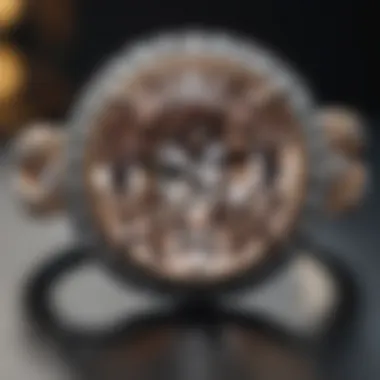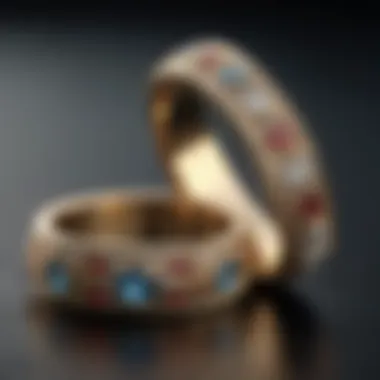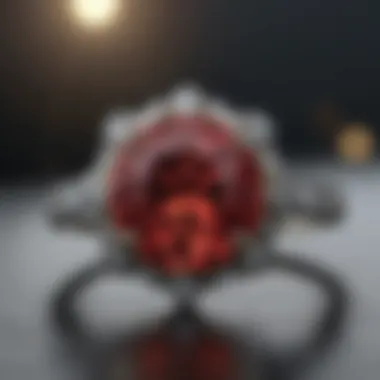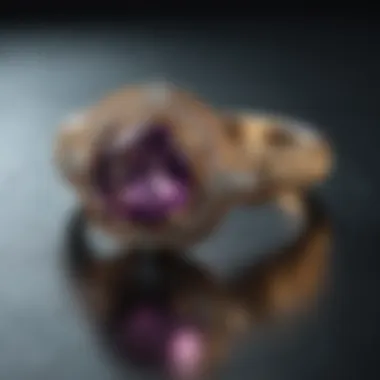Understanding the Dual Symbolism of Wedding Rings


Intro
The journey of love often finds its tangible expression through two significant symbols: wedding bands and engagement rings. These rings not only signify commitment but also carry deep emotional and cultural meanings. Understanding their significance helps one appreciate these accessories beyond their material value. This narrative aims to explore the historical progression, cultural variations, and personal implications tied to these esteemed pieces of jewelry.
When one begins this exploration, it is evident that tradition and personal style play crucial roles in selecting these tokens. Each ring tells a story—of love, partnerships, and often, poignant moments in a person's life. Moreover, each culture has its nuances regarding how these rings are presented and cherished. Such diversity adds layers of richness to their meanings, revealing how they evolve with societal changes.
As we delve deeper, the article will also touch on practical considerations, presenting insights into selecting the right pieces and caring for them. After all, these rings are often designed to last a lifetime and deserve attention and care.
Ultimately, this narrative seeks to illuminate the surrounding significance of wedding bands and engagement rings, serving as a guide for those looking to understand their precious roles in romantic journeys.
Historical Context of Wedding Bands and Engagement Rings
Understanding the historical context of wedding bands and engagement rings provides significant insight into their enduring symbolism and cultural relevance. Over the centuries, these pieces of jewelry have transformed from mere ornaments to meaningful tokens of love and commitment. Through exploring their origins and evolution, we can appreciate how they contribute to modern relationship dynamics, and recognize the invaluable traditions they signify today.
Origins of Engagement Rings
Engagement rings can be traced back to ancient times, with records suggesting that the custom began with the Egyptians, who believed circles were symbols of eternity. They exchanged rings made from reeds and leather, marking a commitment that was both personal and spiritual. It was the Romans, however, who really established the engagement ring as a societal norm. They introduced the use of iron and gold to fashion these bands, signifying a more substantial commitment between couples.
Interestingly, it wasn't until the 13th century that the concept of an engagement ring became widespread across Europe. The first documented instance of a diamond engagement ring was in 1477 when Archduke Maximilian of Austria presented one to Mary of Burgundy. This extravagant gesture didn't just set the bar for engagement expectations; it touted diamonds as a symbol of wealth and commitment that continues to resonate with us today.
Development of Wedding Bands
The tradition of wedding bands often goes hand in hand with that of engagement rings. While the engagement ring signals the promise of marriage, the wedding band signifies the union itself. The use of rings in marriage ceremonies can be traced back to the ancient Greeks and Romans, who regarded the ring as a symbol of fidelity and loyalty. Their circular shape, representing eternity, reinforced the idea that love transcends time.
Historically, wedding bands were quite plain, often made of gold or silver. In the Middle Ages, they became more ornate with the inclusion of precious stones and engravings. Today, while many opt for classic designs, there's a wide variety of bands available—from simple gold rings to intricate patterns adorned with diamonds or gemstones. Each design now encapsulates the personalities of the individuals involved, showcasing their styles while still honoring the unbreakable bond they signify.
Cultural Variations in Symbolism
Cultural interpretations of engagement rings and wedding bands vary widely across the globe. In some Asian cultures, for instance, engagement rings are often elaborate pieces that require significant expense, representing the groom's commitment and ability to provide for his future wife. Meanwhile, in many Western cultures, the engagement ring is typically the focal point, often prioritized in style and extravagance.
In contrast, some societies may see the wedding band more as a symbol of unity rather than status. In certain Native American cultures, the tradition of the wedding ring is often linked to spiritual rituals that celebrate the joining of two families rather than just the couple.
Understanding these cultural variations sheds light on the significance of these pieces, enriching our appreciation for what they represent in diverse contexts. These rings are not merely adornments; they are steeped in history and imbued with meanings that vary across regions, serving as a reminder that love knows no boundaries and is celebrated in myriad ways.
"A ring is not just a piece of jewelry, but a story woven together with threads of commitment and tradition across cultures."
The Role of Engagement Rings in a Relationship
Engagement rings represent more than just a piece of jewelry; they symbolize a profound commitment between two people. The significance of these rings is rooted deeply in their ability to convey feelings of love, fidelity, and future planning. When someone presents an engagement ring, it is not merely a gesture; it is a promise. This promise extends beyond the act itself—it symbolizes the vision of a shared life, filled with dreams and aspirations.
The engagement ring is often the first tangible expression of the bond between partners, marking the transition from casual dating to a more serious relationship. This transformation is significant, as it alters how individuals see themselves and each other within the context of their relationship. It’s important to note that while engagement rings are often thought of as traditional, they can also be personalized, reflecting the unique tastes and characteristics of both partners.
Symbol of Commitment
An engagement ring serves mainly as a symbol of commitment. When a partner says yes to the ring, it encapsulates a shared intent to build a life together. This can foster a deeper sense of loyalty and responsibility. Rings often express the individual personalities of the couple as well, making the commitment feel uniquely theirs. It can be a special touch—to own something that stands for their journey.
Personalization and Self-Expression
When it comes to engagement rings, personal expression plays a crucial role. Couples today have an array of choices, making rings an artistic representation of their relationship. Personalization is a way to showcase individuality; the design can mirror significant milestones or shared values.


Various Styles and Designs
Every engagement ring tells a different story. From vintage designs to contemporary looks, each style comes with its own flair.
- Classic Solitaire: A timeless choice that never goes out of fashion. Its simple elegance is often favored for its understated beauty. The single stone, often a diamond, takes center stage, inviting attention to its brightness.
- Halo: This design features a central stone encircled by smaller stones, amplifying the impact of the center gem while still offering a modern vibe. Many people find this to be a glorious choice that adds a touch of dazzling flair.
- Three-Stone: This style symbolizes the past, present, and future, making it a meaningful option for couples who appreciate depth in their jewelry. With one larger stone and two smaller ones flanking it, this ring whispers tales of mutual growth and enduring love.
Choosing a particular style not only reflects the couple's aesthetic preferences but also encapsulates their unique story.
Selecting the Right Stone
The choice of stone is another pivotal aspect that allows for self-expression. While diamonds are the traditional option, various other gemstones have grown in popularity.
- Sapphire: Blue sapphires are more than just pretty gems; they signify wisdom and nobility. This choice often resonates with people looking for something different yet meaningful.
- Emerald: Symbolizing rebirth and love, an emerald can be a strikingly beautiful option. However, they do require a bit more care due to their brittle nature.
- Moissanite: A lab-created alternative to diamonds, it shines even brighter and is often considered an ethically sourced option.
Each stone has its own allure and story to tell, presenting both advantages and disadvantages regarding durability and care requirements. Therefore, weighing the options based on lifestyle is crucial.
Influence of Popular Culture
Engagement rings also mirror cultural trends. Movies, celebrity weddings, and even online influencers play a significant role in shaping perceptions around what an engagement ring should look like. For instance, the trend of colored gemstones gained momentum after celebrity engagements highlighted unique choices. These cultural influences showcase how engagement rings are not static but evolve with the collective taste of society. They encompass a blend of tradition and innovation, striking a balance between honoring the past while welcoming contemporary ideas.
"An engagement ring is not just jewelry; it's a lifelong promise, engrained with the hopes and dreams of two people, beautifully encapsulated in a tiny, shimmering circle."
The role of engagement rings in relationships thus encapsulates commitment, individuality, and the evolving narrative of love—profoundly intertwined with cultural influences, making them an enduring symbol of romantic devotion.
Wedding Bands: A Lasting Commitment
Wedding bands are often perceived as mere pieces of jewelry, yet their importance stretches far beyond aesthetics. They symbolize a promise, a bond of love that transcends the everyday. Unlike engagement rings, which mark the beginning of a commitment, wedding bands signify its enduring nature. This duality is what makes them profoundly significant in romantic relationships. The simple band, often a plain circle, encapsulates the idea of eternity—the absence of beginning and end, a physical reminder of an emotional vow.
Beyond their physical representation, wedding bands also foster a sense of unity. Couples often choose complementary styles to signify their connection. This isn't just about matching; it’s about creating a language of devotion that reflects their unique relationship. The act of selecting wedding bands can turn into a bonding experience, as partners explore options that resonate with their shared journey.
Benefits and Considerations: When choosing a wedding band, there are several facets to consider. Comfort and durability are chief among these. After all, this band will likely be worn every day. By understanding the significance of wedding bands, couples can make thoughtful decisions that resonate with their personal beliefs and styles. They serve not just as adornments, but as daily affirmations of love, bringing comfort in challenging times and joy during celebrations.
Traditional Significance of Wedding Bands
Tradition plays a pivotal role in the realm of wedding bands. Historically, these rings were believed to embody a couple’s commitment to one another, established in ancient societies, including the Egyptians, who used simple braided reeds. Symbolically, the ring’s circular shape represents the never-ending bond between partners. It reflects the commitment to face life together, come what may.
In many cultures, the band is often worn on the fourth finger of the left hand, a belief that traces back to the ancient Romans who thought a vein in that finger led directly to the heart—an idea that has survived through the ages. Wedding bands thus carry a weight of tradition, grounded in deeply held beliefs about love and commitment, which continues to resonate with many couples today.
Modern Variations and Styles
As society evolves, so too do the forms and styles of wedding bands. The traditional plain gold or platinum bands have given way to a melting pot of designs and materials that cater to diverse tastes and individual stories. Couples now have an array of options that reflect their personalities and heritage, straying away from one-size-fits-all.
Material Choices
Material choices play a crucial part in the selection of wedding bands. The materials range from classic gold and silver to more modern elements like titanium and tungsten. Gold remains a favorite, presenting various hues: yellow, white, and rose. Each type has distinct characteristics; rose gold, for example, offers a romantic and vintage feel, while white gold boasts a sleek and contemporary look.
Moreover, many couples are opting for alternative materials such as wood or even ceramics, which can provide a unique appeal that traditional metals lack. These choices often reflect personal values or shared experiences, making them particularly meaningful. However, with novelty comes a level of maintenance—some materials require more care than others, presenting both pros and cons to the couple’s lifestyle.
Design Innovations


Design innovations are also reshaping the landscape of wedding bands. Contemporary jewelers find creative ways to blend traditional designs with modern aesthetics. Intricate engravings, custom shapes, and mix-and-match styles are becoming increasingly popular. Some couples choose bands adorned with gemstones, adding a personal touch while ensuring their rings stand out.
A notable advantage of these innovations is the flexibility they offer. Couples can craft rings that truly tell their story, representing experiences or inside jokes through design. However, with so many choices, one must tread carefully; overly intricate designs might not wear as well over time, leading to potential issues down the line, which is an aspect worth keeping in mind during selection.
The Circle of Love Symbolism
Finally, the circle of love symbolism associated with wedding bands connects back to the very heart of romantic commitment. This simple yet profound shape echoes themes of continuity and eternity. In many cultures, this symbolism extends beyond romance, engaging concepts like family, unity, and loyalty. The act of slipping on a wedding band becomes not just a ceremonial gesture but a daily reminder of the love that binds partners together.
It's essential to recognize that the significance of wedding bands reaches far beyond craftsmanship. Indeed, they represent an intimate fusion of history, culture, and individual narrative, contributing to their lasting commitment in a couple’s life. Couples today create traditions anew, defining what their wedding band means to them, echoing sentiments of love that endure through the ages.
The Intersection of Engagement Rings and Wedding Bands
In the realm of romantic unions, engagement rings and wedding bands serve not merely as adornments but as profound symbols of commitment and devotion. Their intersection represents a tapestry woven from threads of history, culture, and personal significance. Understanding this overlap can illuminate the way these treasures function in the dynamics of modern relationships, providing clarity on their individual and collective meanings.
Complementary Nature of the Symbols
Engagement rings typically symbolize the promise of marriage, while wedding bands signify the actual union. Together, they encapsulate the journey from intention to commitment. The engagement ring often flaunts a striking design, highlighting its role as the focal point of a couple's romantic milestones, whereas the wedding band is typically more understated, representing the solidity of the relationship.
Their complementary nature is key. An engagement ring may dazzle with a single large stone or intricate patterns, while the wedding band serves to frame it beautifully, much like the perfect finishing touch on a well-curated masterpiece. Whether a couple opts for matching styles or personalized choices, this balance reflects their unique love story.
Stacking Techniques and Trends
In recent years, stacking rings have gained popularity as a reflection of personal expression. Combining different types of rings allows couples to create a bespoke look that tells their story. Here's how stacking can be approached:
- Mixing Elements: Different metals and gemstones can be layered to create visually appealing combinations. For instance, pairing a classic gold band with a modern diamond-studded ring can showcase both tradition and contemporary flair.
- Establishing Themes: Couples often choose bands that reflect shared interests or milestones in their relationship—perhaps a ring with a specific stone they both admire or a style that reflects a memorable trip.
- Following Trends: Social media influences can spark new trends, including the popularity of colored stones or unique shapes. For example, sapphire engagement rings have caught the eye of many, offering an alternative to the conventional diamond with personal significance attached.
Caring for Your Rings
Rings hold sentimental value and require proper care to maintain their beauty over time. Understanding how to care for both engagement rings and wedding bands can ensure they remain as stunning as the day they were exchanged.
Cleaning Techniques
Adopting the right cleaning routines is essential for prolonging the shine and clarity of your rings. Simple cleaning solutions, like a mix of warm water and mild soap, can help. This method is beneficial because it is gentle on the materials and can be done at home. You simply soak the rings for a few minutes, followed by a soft brushing with a toothbrush to remove any buildup. Regular cleaning keeps them looking their best, enabling the sparkle of gemstones to shine brightly.
"Routine is everything when it comes to ring care; a little effort goes a long way in preserving these cherished tokens of love."
Avoiding Damage
Being mindful of where and how rings are worn is critical to prevent unnecessary wear and tear. Some key points to consider include:
- Removing Rings for Activities: It's wise to take off rings while doing tasks such as cleaning, gardening, or exercising. The risk of scratches or even loss can be significantly reduced by following this precaution.
- Storage Solutions: When not wearing the rings, proper storage matters. Keeping them in a soft-lined jewelry box prevents scratches and tangling, ensuring that they remain in pristine condition.
- Regular Inspections: Periodic checks for loose stones or damaged settings can catch potential problems early, allowing for timely fixes.
Embracing these considerations about cleaning and damage prevention contributes greatly to maintaining the rings' integrity, ensuring that their symbolic essence remains as strong as ever, through the passage of time.
Challenges and Considerations in Choosing Rings
Selecting wedding bands and engagement rings can be an emotionally charged process. These pieces aren’t just adornments; they carry with them a weight of significance as symbols of love and commitment. In this section, we will look into the challenges you may face and the essential considerations to keep in mind when making this pivotal choice.
Understanding Personal Preferences


Choosing rings is deeply personal, reflecting individual style, taste, and values. It's not enough to just consider trends or what is seen in commercials. You have to think about what resonates with you. Are you someone who prefers vintage styles? Or do you veer more toward modern designs?
It's helpful to start by exploring different styles that align with your personal taste. You might like a simple band or a more ornate design adorned with gemstones. Visiting jewelry stores, examining online galleries, or even browsing social media can stir inspiration. Look for design elements you connect with, such as:
- Metal Type: Gold, silver, platinum, or perhaps something more unconventional like titanium or palladium.
- Stone Selection: Would a diamond take your fancy, or do colored gemstones appeal to your aesthetic?
- Shape and Cut: Round, princess, or pear-cut might change the way the ring reflects light.
Pulling all these elements together can be quite a task, but the goal is for the ring to resonate with your identity.
Budgeting for Quality
Budgeting for rings doesn’t have to feel like a bitter pill to swallow. While it’s easy to get caught up in the allure of extravagant options showcased in well-polished advertisements, it’s crucial to ground your decision in financial reality. The adage "you get what you pay for" often rings true in jewelry, especially when it comes to quality.
A practical approach could involve setting a real budget up front and sticking to it. This can involve considering:
- Total Costs: Don’t forget insurance and maintenance costs on top of the purchase.
- Balance Between Price and Quality: Seek out reputable jewelers who provide certifications for stones and materials used.
- Financing Options: Some stores offer payment plans, allowing you to invest in a quality piece without immediate financial strain.
Having a clear budget in mind helps narrow down choices without sacrificing the quality or meaning behind the rings.
Ethical Sourcing of Materials
In recent years, there has been increasing awareness around the ethical implications of jewelry sourcing. When purchasing wedding bands and engagement rings, it's worth considering whether the materials used are sourced responsibly. Opting for ethically sourced materials not only aligns with personal values but also contributes to broader social good.
To ensure ethical sourcing, one may want to consider:
- Conflict-Free Diamonds: Prioritize jewelers who can prove their diamonds are conflict-free, meaning they aren’t sourced from war zones, supporting unethical practices.
- Recycled Metals: Many jewelers now provide options for rings made from recycled gold or silver, significantly reducing environmental impact.
- Lab-Created Gemstones: These stones offer an ethical alternative to mined gems, with a reduced carbon footprint.
Engaging with the right resources and doing a bit of research can provide peace of mind.
Taking the time to reflect on your choices not only enhances your connection to the rings but also honors the commitment they represent.
Ultimately, the journey of choosing your wedding bands and engagement rings should reflect both your heartfelt feelings and your values. This balance of personal expression and thoughtful considerations forms a foundation for a meaningful union, making this beautiful endeavor all the more significant.
And Beyond: Evolving Trends in Symbols of Love
The landscape of wedding bands and engagement rings is ever-changing, influenced by cultural shifts, technological advancements, and personal expression. As society evolves, so do the symbols of love, leading to emerging trends that reflect the values and aesthetics of contemporary relationships. These trends enrich our understanding of how couples express their commitments, moving beyond traditional norms and embracing individuality.
Emerging Materials and Designs
In recent years, there's been a noticeable shift towards unconventional materials for rings. No longer is gold the only metal that adorns the fingers of brides and grooms-to-be. Today’s couples are exploring alternative metals such as titanium, cobalt, and even ceramic. These materials offer durability and a unique aesthetic, appealing to those who wish for something distinct.
In addition, eco-conscious designs are gaining traction. With the rise of sustainability-conscious couples, recycled metals and ethically sourced stones are becoming popular choices. The design landscape is also experiencing an uptick in vintage and heirloom pieces, where family treasures are restored or repurposed, breathing new life into meaningful artifacts that carry personal history.
The Role of Technology in Ring Design
Technology is revolutionizing the way engagement rings and wedding bands are designed and manufactured. The rise of 3D printing has made it possible for custom designs to be brought to life at a fraction of the cost and time compared to traditional methods. This has opened the door for couples to express their uniqueness through tailor-made pieces, reflecting both personal taste and story.
Moreover, technology allows for greater interactivity and connection. Websites and apps that let users design their own rings, choosing every facet, have made personalized jewelry accessible to more people. Virtual reality is even beginning to play a role, enabling couples to visualize how different stones and settings will look before committing to a design. This blend of creativity and technology brings a new dimension to the selection process and enhances the sentimental value of these symbols.
Cultural Shifts Affecting Traditional Norms
The traditional narrative surrounding engagement rings and wedding bands is constantly under scrutiny. There’s a growing acknowledgment that love and commitment don’t fit neatly into predefined templates. Many couples are rejecting the notion that engagement rings must be diamond-centric in favor of gemstones that hold personal meaning or aesthetic appeal.
This trend mirrors a broader cultural shift toward inclusivity and diversity, offering space for expressions of love that go beyond heteronormative frameworks. Non-binary and LGBTQ+ couples are using rings that better align with their identities, seeking designs that resonate with their experiences. Furthermore, societal acceptance of cohabitation before marriage has made the symbolism of engagement rings and wedding bands more fluid, as they may no longer strictly signify a future wedding but rather a shared journey.
Overall, the evolving trends in symbols of love reflect a vibrant dialogue between personal expression and cultural norms. As new materials, technologies, and ideas emerge, the significance of wedding bands and engagement rings continues to transform, adapting to the ever-changing landscape of love and relationships.
"The rings we wear are no longer just ornaments, they are stories of who we are, where we’ve been, and where we’re going."







